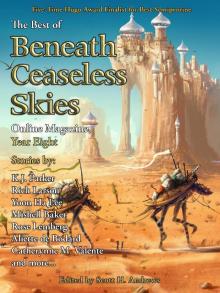


Into Thin Air, Page 2
Jon Krakauer
Ed Viesturs USA, climber and film talent
Araceli Segarra Spain, climber and film talent
Sumiyo Tsuzuki Japan, climber and film talent
Robert Schauer Austria, climber and cinematographer
Paula Barton Viesturs USA, Base Camp manager
Audrey Salkeld U.K., journalist
Liz Cohen USA, film production manager
Liesl Clark USA, film producer and writer
Wongchu Sherpa Nepal, sirdar
Jangbu Sherpa Nepal, lead camera Sherpa
Taiwanese National Expedition
“Makalu” Gau Ming-Ho Taiwan, leader
Chen Yu-Nan Taiwan, climber
Kao Tien Tzu Taiwan, climber
Chang Jung Chang Taiwan, climber
Hsieh Tzu Sheng Taiwan, climber
Chhiring Sherpa Nepal, sirdar
Kami Dorje Sherpa Nepal, climbing Sherpa
Ngima Gombu Sherpa Nepal, climbing Sherpa
Mingma Tshering Sherpa Nepal, climbing Sherpa
Tenzing Nuri Sherpa Nepal, climbing Sherpa
Dorje Sherpa Nepal, climbing Sherpa
Pasang Tamang Nepal, climbing Sherpa
Ki Kami Sherpa Nepal, climbing Sherpa
Johannesburg Sunday Times Expedition
Ian Woodall U.K., leader
Bruce Herrod U.K., deputy leader and photographer
Cathy O’Dowd South Africa, climber
Deshun Deysel South Africa, climber
Edmund February South Africa, climber
Andy de Klerk South Africa, climber
Andy Hackland South Africa, climber
Ken Woodall South Africa, climber
Tierry Renard France, climber
Ken Owen South Africa, journalist and trekker
Philip Woodall U.K., Base Camp manager
Alexandrine Gaudin France, administrative assistant
Dr. Charlotte Noble South Africa, team doctor
Ken Vernon Australia, journalist
Richard Shorey South Africa, photographer
Patrick Conroy South Africa, radio journalist
Ang Dorje Sherpa Nepal, climbing sirdar
Pemba Tendi Sherpa Nepal, climbing Sherpa
Jangbu Sherpa Nepal, climbing Sherpa
Ang Babu Sherpa Nepal, climbing Sherpa
Dawa Sherpa Nepal, climbing Sherpa
Alpine Ascents International Guided Expedition
Todd Burleson USA, leader and guide
Pete Athans USA, guide
Jim Williams USA, guide
Dr. Ken Kamler USA, client and team doctor
Charles Corfield USA, client
Becky Johnston USA, trekker and screenwriter
International Commercial Expedition
Mal Duff U.K., leader
Mike Trueman Hong Kong, deputy leader
Michael Burns U.K., Base Camp manager
Dr. Henrik Jessen Hansen Denmark, expedition doctor
Veikka Gustafsson Finland, climber
Kim Sejberg Denmark, climber
Ginge Fullen U.K., climber
Jaakko Kurvinen Finland, climber
Euan Duncan U.K., climber
Himalayan Guides Commercial Expedition
Henry Todd U.K., leader
Mark Pfetzer USA, climber
Ray Door USA, climber
Michael Jorgensen Denmark, climber
Brigitte Muir Australia, climber
Paul Deegan U.K., climber
Neil Laughton U.K., climber
Graham Ratcliffe U.K., climber
Thomas Sjögren Sweden, climber
Tina Sjögren Sweden, climber
Kami Nuru Sherpa Nepal, sirdar
Swedish Solo Expedition
Göran Kropp Sweden, climber
Frederic Bloomquist Sweden, filmmaker
Ang Rita Sherpa Nepal, climbing Sherpa and film crew member
Norwegian Solo Expedition
Petter Neby Norway, climber
New Zealand-Malaysian Guided Pumori Expedition
Guy Cotter New Zealand, leader and guide
Dave Hiddleston New Zealand, guide
Chris Jillet New Zealand, guide
American Commercial Pumori/Lhotse Expedition
Dan Mazur USA, leader
Scott Darsney USA, climber and photographer
Chantal Mauduit France, climber
Stephen Koch USA, climber and snowboarder
Brent Bishop USA, climber
Jonathan Pratt U.K., climber
Diane Taliaferro USA, climber
Dave Sharman U.K., climber
Tim Horvath USA, climber
Dana Lynge USA, climber
Martha Johnson USA, climber
Nepali Everest Cleaning Expedition
Sonam Gyalchhen Sherpa Nepal, leader
Himalayan Rescue Association Clinic
(in Pheriche Village)
Dr. Jim Litch USA, staff doctor
Dr. Larry Silver USA, staff doctor
Dr. Cecile Bouvray France, staff doctor
Laura Ziemer USA, assistant
Indo-Tibetan Border Police Everest Expedition
(climbing from the Tibetan side of the mountain)
Mohindor Singh India, leader
Harbhajan Singh India, deputy leader and climber
Tsewang Smanla India, climber
Tsewang Paljor India, climber
Dorje Morup India, climber
Hira Ram India, climber
Tashi Ram India, climber
Sange Sherpa India, climbing Sherpa
Nadra Sherpa India, climbing Sherpa
Koshing Sherpa India, climbing Sherpa
Japanese-Fukuoka Everest Expedition
(climbing from the Tibetan side of the mountain)
Koji Yada Japan, leader
Hiroshi Hanada Japan, climber
Eisuke Shigekawa Japan, climber
Pasang Tshering Sherpa Nepal, climbing Sherpa
Pasang Kami Sherpa Nepal, climbing Sherpa
Any Gyalzen Nepal, climbing Sherpa
* Not everyone present on Mt. Everest in the spring of 1996 is listed.
ONE
EVEREST SUMMIT
MAY 10, 1996 • 29,028 FEET
It would seem almost as though there were a cordon drawn round the upper part of these great peaks beyond which no man may go. The truth of course lies in the fact that, at altitudes of 25,000 feet and beyond, the effects of low atmospheric pressure upon the human body are so severe that really difficult mountaineering is impossible and the consequences even of a mild storm may be deadly, that nothing but the most perfect conditions of weather and snow offers the slightest chance of success, and that on the last lap of the climb no party is in a position to choose its day.…
No, it is not remarkable that Everest did not yield to the first few attempts; indeed, it would have been very surprising and not a little sad if it had, for that is not the way of great mountains. Perhaps we had become a little arrogant with our fine new technique of ice-claw and rubber slipper, our age of easy mechanical conquest. We had forgotten that the mountain still holds the master card, that it will grant success only in its own good time. Why else does mountaineering retain its deep fascination?
Eric Shipton, in 1938
Upon That Mountain
Straddling the top of the world, one foot in China and the other in Nepal, I cleared the ice from my oxygen mask, hunched a shoulder against the wind, and stared absently down at the vastness of Tibet. I understood on some dim, detached level that the sweep of earth beneath my feet was a spectacular sight. I’d been fantasizing about this moment, and the release of emotion that would accompany it, for many months. But now that I was finally here, actually standing on the summit of Mount Everest, I just couldn’t summon the energy to care.
It was early in the afternoon of May 10, 1996. I hadn’t slept in fifty-seven hours. The only food I’d been able to force down over the preceding three days was a bowl of ramen soup and a handful of peanut M&Ms. Weeks of vio
lent coughing had left me with two separated ribs that made ordinary breathing an excruciating trial. At 29,028 feet up in the troposphere, so little oxygen was reaching my brain that my mental capacity was that of a slow child. Under the circumstances, I was incapable of feeling much of anything except cold and tired.
I’d arrived on the summit a few minutes after Anatoli Boukreev, a Russian climbing guide working for an American commercial expedition, and just ahead of Andy Harris, a guide on the New Zealand–based team to which I belonged. Although I was only slightly acquainted with Boukreev, I’d come to know and like Harris well during the preceding six weeks. I snapped four quick photos of Harris and Boukreev striking summit poses, then turned and headed down. My watch read 1:17 P.M. All told, I’d spent less than five minutes on the roof of the world.
A moment later, I paused to take another photo, this one looking down the Southeast Ridge, the route we had ascended. Training my lens on a pair of climbers approaching the summit, I noticed something that until that moment had escaped my attention. To the south, where the sky had been perfectly clear just an hour earlier, a blanket of clouds now hid Pumori, Ama Dablam, and the other lesser peaks surrounding Everest.
Later—after six bodies had been located, after a search for two others had been abandoned, after surgeons had amputated the gangrenous right hand of my teammate Beck Weathers—people would ask why, if the weather had begun to deteriorate, had climbers on the upper mountain not heeded the signs? Why did veteran Himalayan guides keep moving upward, ushering a gaggle of relatively inexperienced amateurs—each of whom had paid as much as $65,000 to be taken safely up Everest—into an apparent death trap?
Nobody can speak for the leaders of the two guided groups involved, because both men are dead. But I can attest that nothing I saw early on the afternoon of May 10 suggested that a murderous storm was bearing down. To my oxygen-depleted mind, the clouds drifting up the grand valley of ice known as the Western Cwm* looked innocuous, wispy, insubstantial. Gleaming in the brilliant midday sun, they appeared no different from the harmless puffs of convection condensation that rose from the valley almost every afternoon.
As I began my descent I was extremely anxious, but my concern had little to do with the weather: a check of the gauge on my oxygen tank had revealed that it was almost empty. I needed to get down, fast.
The uppermost shank of Everest’s Southeast Ridge is a slender, heavily corniced fin of rock and wind-scoured snow that snakes for a quarter mile between the summit and a subordinate pinnacle known as the South Summit. Negotiating the serrated ridge presents no great technical hurdles, but the route is dreadfully exposed. After leaving the summit, fifteen minutes of cautious shuffling over a 7,000-foot abyss brought me to the notorious Hillary Step, a pronounced notch in the ridge that demands some technical maneuvering. As I clipped into a fixed rope and prepared to rappel over the lip, I was greeted with an alarming sight.
Thirty feet below, more than a dozen people were queued up at the base of the Step. Three climbers were already in the process of hauling themselves up the rope that I was preparing to descend. Exercising my only option, I unclipped from the communal safety line and stepped aside.
The traffic jam was comprised of climbers from three expeditions: the team I belonged to, a group of paying clients under the leadership of the celebrated New Zealand guide Rob Hall; another guided party headed by the American Scott Fischer; and a noncommercial Taiwanese team. Moving at the snail’s pace that is the norm above 26,000 feet, the throng labored up the Hillary Step one by one, while I nervously bided my time.
Harris, who’d left the summit shortly after I did, soon pulled up behind me. Wanting to conserve whatever oxygen remained in my tank, I asked him to reach inside my backpack and turn off the valve on my regulator, which he did. For the next ten minutes I felt surprisingly good. My head cleared. I actually seemed less tired than I had with the gas turned on. Then, abruptly, I sensed that I was suffocating. My vision dimmed and my head began to spin. I was on the brink of losing consciousness.
Instead of turning my oxygen off, Harris, in his hypoxically impaired state, had mistakenly cranked the valve open to full flow, draining the tank. I’d just squandered the last of my gas going nowhere. There was another tank waiting for me at the South Summit, 250 feet below, but to get there I would have to descend the most exposed terrain on the entire route without the benefit of supplemental oxygen.
And first I had to wait for the mob to disperse. I removed my now useless mask, planted my ice ax into the mountain’s frozen hide, and hunkered on the ridge. As I exchanged banal congratulations with the climbers filing past, inwardly I was frantic: “Hurry it up, hurry it up!” I silently pleaded. “While you guys are fucking around here, I’m losing brain cells by the millions!”
Most of the passing crowd belonged to Fischer’s group, but near the back of the parade two of my teammates eventually appeared, Rob Hall and Yasuko Namba. Demure and reserved, the forty-seven-year-old Namba was forty minutes away from becoming the oldest woman to climb Everest and the second Japanese woman to reach the highest point on each continent, the so-called Seven Summits. Although she weighed just ninety-one pounds, her sparrowlike proportions disguised a formidable resolve; to an astounding degree, Yasuko had been propelled up the mountain by the unwavering intensity of her desire.
Later still, Doug Hansen arrived atop the Step. Another member of our expedition, Doug was a postal worker from a Seattle suburb who’d become my closest friend on the mountain. “It’s in the bag!” I yelled over the wind, trying to sound more upbeat than I felt. Exhausted, Doug mumbled something from behind his oxygen mask that I didn’t catch, shook my hand weakly, then continued plodding upward.
At the very end of the line was Scott Fischer, whom I knew casually from Seattle, where we both lived. Fischer’s strength and drive were legendary—in 1994 he’d climbed Everest without using bottled oxygen—so I was surprised at how slowly he was moving and how hammered he looked when he pulled his mask aside to say hello. “Bruuuuuuce!” he wheezed with forced cheer, employing his trademark frat-boyish greeting. When I asked how he was doing, Fischer insisted that he was feeling fine: “Just dragging ass a little today for some reason. No big deal.” With the Hillary Step finally clear, I clipped into the strand of orange rope, swung quickly around Fischer as he slumped over his ice ax, and rappelled over the edge.
It was after three o’clock when I made it down to the South Summit. By now tendrils of mist were streaming over the 27,923-foot top of Lhotse and lapping at Everest’s summit pyramid. No longer did the weather look so benign. I grabbed a fresh oxygen cylinder, jammed it onto my regulator, and hurried down into the gathering cloud. Moments after I dropped below the South Summit, it began to snow lightly and visibility went to hell.
Four hundred vertical feet above, where the summit was still washed in bright sunlight under an immaculate cobalt sky, my compadres dallied to memorialize their arrival at the apex of the planet, unfurling flags and snapping photos, using up precious ticks of the clock. None of them imagined that a horrible ordeal was drawing nigh. Nobody suspected that by the end of that long day, every minute would matter.
* The Western Cwm, pronounced koom, was named by George Leigh Mallory, who first saw it during the initial Everest expedition of 1921 from the Lho La, a high pass on the border between Nepal and Tibet. Cwm is a Welsh term for valley or cirque.
TWO
DEHRA DUN, INDIA
1852 • 2,234 FEET
Far from the mountains in winter, I discovered the blurred photo of Everest in Richard Halliburton’s Book of Marvels. It was a miserable reproduction in which the jagged peaks rose white against a grotesquely blackened and scratched sky. Everest itself, sitting back from the front ones, didn’t even appear highest, but it didn’t matter. It was; the legend said so. Dreams were the key to the picture, permitting a boy to enter it, to stand at the crest of the windswept ridge, to climb toward the summit, now no longer far above.…
<
br /> This was one of those uninhibited dreams that come free with growing up. I was sure that mine about Everest was not mine alone; the highest point on earth, unattainable, foreign to all experience, was there for many boys and grown men to aspire toward.
Thomas F. Hornbein
Everest: The West Ridge
The actual particulars of the event are unclear, obscured by the accretion of myth. But the year was 1852, and the setting was the offices of the Great Trigonometrical Survey of India in the northern hill station of Dehra Dun. According to the most plausible version of what transpired, a clerk rushed into the chambers of Sir Andrew Waugh, India’s surveyor general, and exclaimed that a Bengali computer named Radhanath Sikhdar, working out of the Survey’s Calcutta bureau, had “discovered the highest mountain in the world.” (In Waugh’s day a computer was a job description rather than a machine.) Designated Peak XV by surveyors in the field who’d first measured the angle of its rise with a twenty-four-inch theodolite three years earlier, the mountain in question jutted from the spine of the Himalaya in the forbidden kingdom of Nepal.
Until Sikhdar compiled the survey data and did the math, nobody had suspected that there was anything noteworthy about Peak XV. The six survey sites from which the summit had been triangulated were in northern India, more than a hundred miles from the mountain. To the surveyors who shot it, all but the summit nub of Peak XV was obscured by various high escarpments in the foreground, several of which gave the illusion of being much greater in stature. But according to Sikhdar’s meticulous trigonometric reckoning (which took into account such factors as curvature of the earth, atmospheric refraction, and plumb-line deflection), Peak XV stood 29,002* feet above sea level, the planet’s loftiest point.
In 1865, nine years after Sikhdar’s computations had been confirmed, Waugh bestowed the name Mount Everest on Peak XV, in honor of Sir George Everest, his predecessor as surveyor general. As it happened, Tibetans who lived to the north of the great mountain already had a more mellifluous name for it, Jomolungma, which translates to “goddess, mother of the world,” and Nepalis who resided to the south reportedly called the peak Deva-dhunga, “Seat of God.”† But Waugh pointedly chose to ignore these native appellations (as well as official policy encouraging the retention of local or ancient names), and Everest was the name that stuck.














